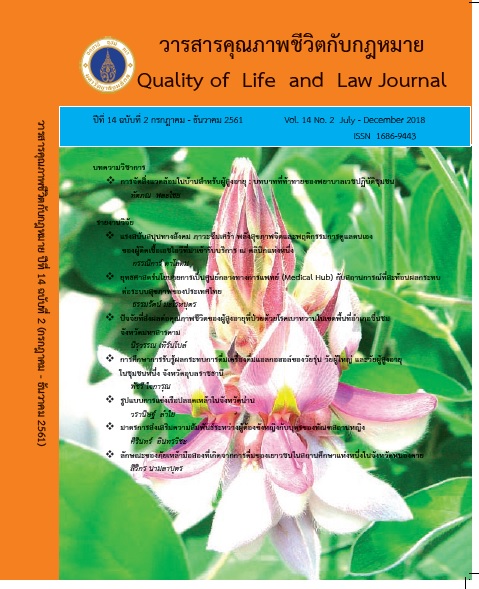The model of alcohol-free boat racing in Nan Province
Main Article Content
Abstract
A research study on alcohol-free boat racing in Nan province had two main objectives: (1) To study the process of boat racing without alcohol in Nan province, (2) To propose a model of alcohol-free boat racing in Nan Province. This research utilizes qualitative data collection through in-depth interviews and participatory observation. There were 25 key informants include the Chief executive of the Sub-district Municipality or a representative, community leaders, boat racing enthusiasts, police officers, monks, StopDrink Network representatives, and people attending a long-boat race. The people were 18 years of age and over, and were selected from spectators who have participated in the long-boat race more than once and have engaged in some activities related to the long boat race.
The study results showed that: 1. The process of boat racing without alcohol in Nan province was systematically planned and organized. Prior to the boat race at the End of Buddhist Lent Day or “Wan Ok Phansa”, the village board will issue a statement of declaration to appoint various committees to manage and facilitate different tasks. The process was divided into four phases: the preparation period, the planned implementation period, the competition period, and the post-competition period. However, for the event of the alcohol-free boat racing of Wiang Sa district in Nan province, there was a boat blessing ceremony on land before the boat race. In the ceremony performed by Buddhist monks, a bottle of spirit together with two whole boiled chickens or a swine head were presented as religious offerings. A tradition of constant use of Thai rice whisky or the so-called “white spirit” in such rituals is a solemn belief that has passed down from the ancient times to the present day. At the boat blessing ceremony, prior to the long boat race, these oblations, especially the white spirit, were offered and sacrificed to a supernatural figure. After the ritual had finished, however, the villagers helped keep the liquor out of the event to avoid drinking and/or selling alcohol on the day of the race. The factors that led to the success of an alcohol-free boat racing event in Nan Province are the vision of the event operator, a strong community, some networking in the campaign, the unique identity of Nan boats, and the outreach of publicity. 2. The proposed model (by the researchers), dubbed “LIRP Model”, for a successful free-alcohol boat racing in Nan Province consists of four components: (1) Community Leaders = L (2) Identity = I (3) Community Rules = R and (4) Community Participation = P
Some suggestions were (1) that the community leaders act as role models by not consuming alcohol and (2) to encourage continuous enforcement of rules and community by laws on alcohol consumption. To enhance the boat racing event to a greater extent, the uniqueness of the alcohol-free Nan boat racing and the community health promotion could be publicized, campaigned, and promoted simultaneously.
Article Details
- บทความหรือข้อคิดเห็นใดๆ ในวารสารคุณภาพชีวิตกับกฎหมายเป็
- กองบรรณาธิการไม่สงวนสิทธิ์
References
สู่การเมืองใหม่และประชาธิปไตยแบบมีส่วนร่วม. กรุงเทพฯ : มูลนิธิองค์กรกลางเพื่อประชาธิปไตย.
กันต์ เชิญรุ่งโรจน์ และคณะ. (2548). รายงานผลสำรวจพฤติกรรมเสี่ยงโรคไม่ติดต่อและการบาดเจ็บ พ.ศ.2547-2548. กรุงเทพฯ: กรมควบคุมโรค กระทรวง
สาธารณสุข.
กวินธร เสถียร และ พัชรินทร์ สิรสุนทร. (2557). รายงานวิจัยเรื่อง โครงการพัฒนานวัตกรรมทางสังคมเพื่อส่งเสริมสุขภาพเชิงสร้างสรรค์ในประเพณีการแข่งเรือ อำเภอ
เวียงสา จังหวัดน่าน.สนับสนุนโดยงบประมาณแผ่นดิน มหาวิทยาลัยนเรศวร.
เกตุ สมบัติแก้ว. (2550). รูปแบบการกำหนดมาตรการเพื่อลดการบริโภคเครื่องดื่มแอลกอฮอล์ของประชาชน ในเขตอำเภอเวียงสา จังหวัดน่าน. ปริญญารัฐประศาสน
ศาสตรมหาบัณฑิต สาขาการบริหารและพัฒนาประชาคมเมืองและชนบท มหาวิทยาลัยราชภัฏอุตรดิตถ.
พงศ์เทพ วงศ์วัชรไพบูลย์.(มปป.).คนน่านได้อะไรจากงานแข่งเรือไม่มีเหล้าเบียร์. เอกสารประกอบการประชุมของสำนักงานกองทุนสนับสนุนการสร้างเสริมคุณภาพ.
เยาวลักษณ์ อนุรักษณ์. (2558). สารานุกรมจังหวัดน่าน. องค์การบริหารส่วนตำบล ศูนย์ราชการจังหวัดน่าน. พิมพ์ครั้งที่ 1. กรุงเทพฯ: อมรินทร์พริ้นติ้งแอนด์พับลิชชิ่ง.
สุภาพร อาญาเมือง และอมร สุวรรณนิมิต. (2556). บทความ “การประยุกต์ใช้ภูมิปัญญาท้องถิ่นและวิถีชีวิตชุมชนในการแก้ไขปัญหาการดื่มสุราในชุมชนชนบทจังหวัด
บุรีรัมย์”. วารสารวิทยาศาสตร์และเทคโนโลยี มหาวิทยาลัยมหาสารคาม ฉบับพิเศษ การประชุมวิชาการ มหาวิทยาลัยมหาสารคามวิจัย ครั้งที่ 9 การวิจัยสู่
ประชาคมอาเซียน. สำนักงานกองบรรณาธิการกองส่งเสริมการวิจัยและบริการ มหาวิทยาลัยมหาสารคาม.
สำนักงานเครือข่ายองค์กรงดเหล้า.(2558). แข่งเรือปลอดเหล้า ชิงจ้าวสายน้ำปี 8. สืบค้นเมื่อ 28 ธันวาคม 2558. เข้าถึงได้จาก
http://www.thaihealth.or.th/Content/29413-แข่งเรือปลอดเหล้า ชิงจ้าวสายน้ำปี8.html
อาภรณ์ จันทร์สมวงศ์. (2554). เอกสารชุดความรู้งานรณรงค์งดเหล้า. แข่งเรือปลอดเหล้าจังหวัด น่าน. พิมพ์ครั้งที่ 1. กรุงเทพฯ.สำนักงานเครือข่ายองค์กรงดเหล้า.
Keeves, P. J. (1988). “Educational research methodology, and measurement: An international handbook”. Oxford, England: Pergamon Press.


